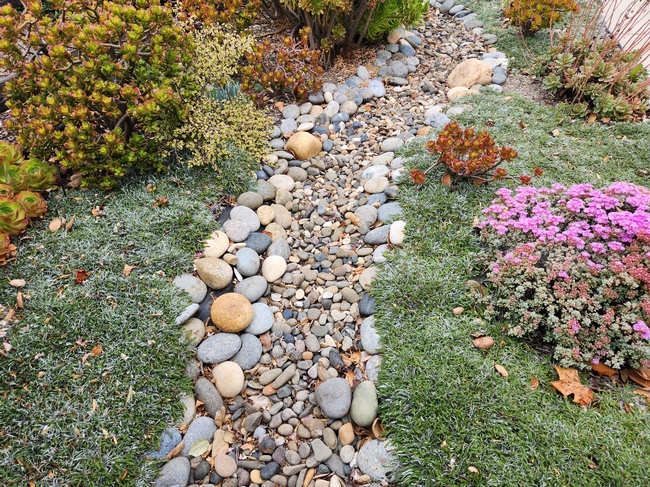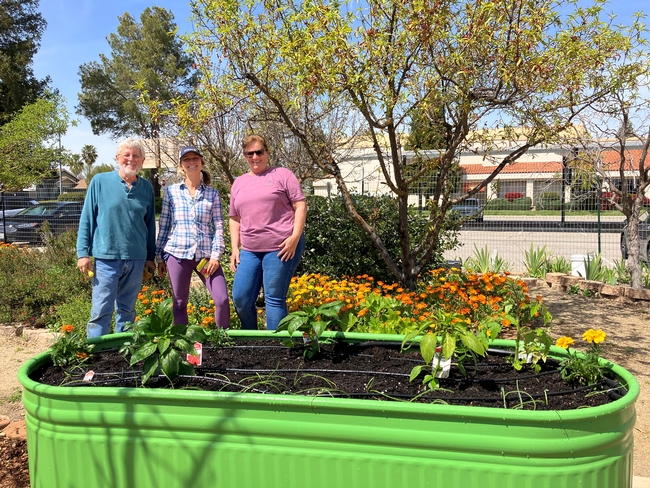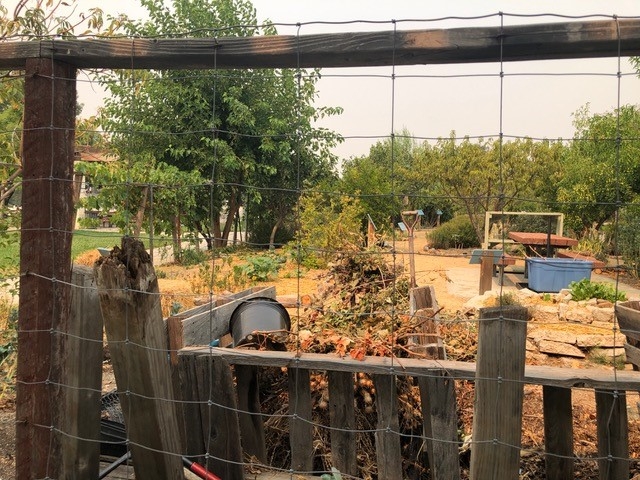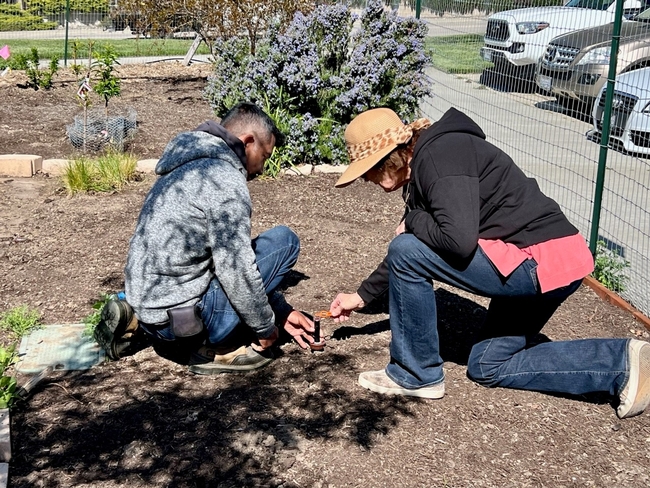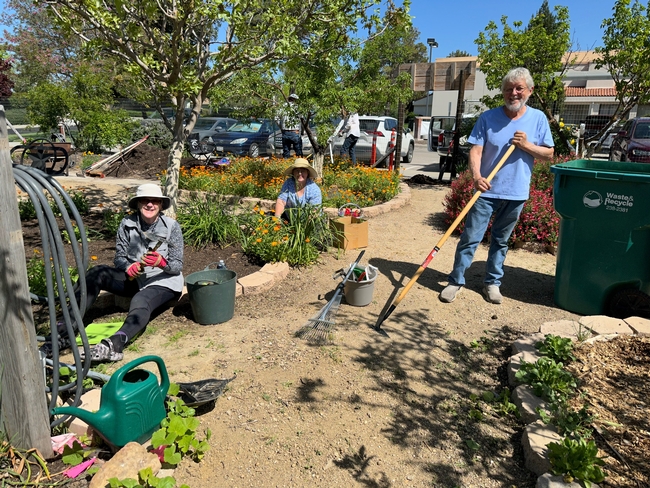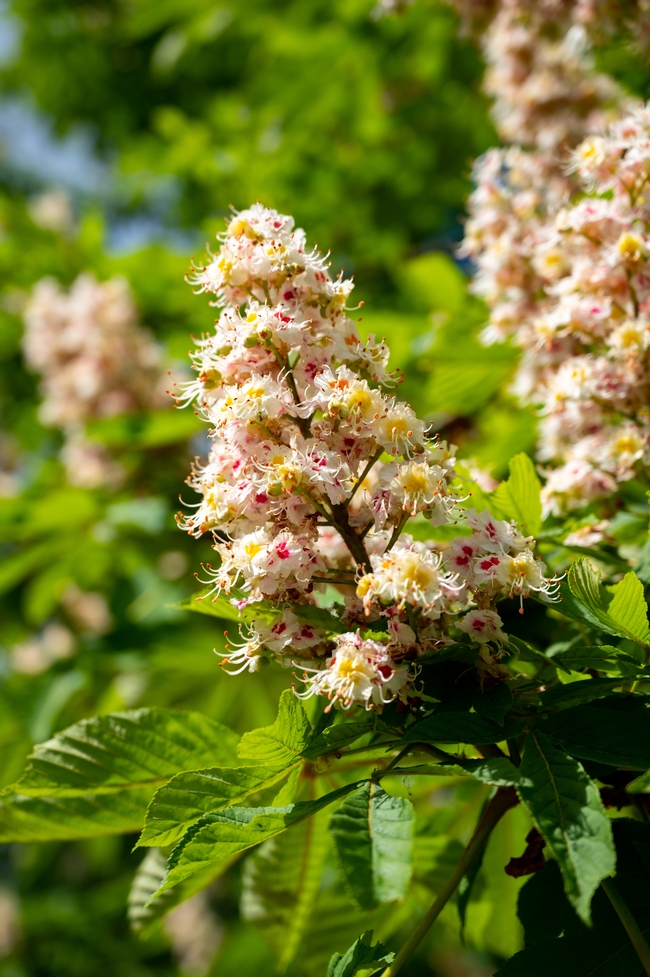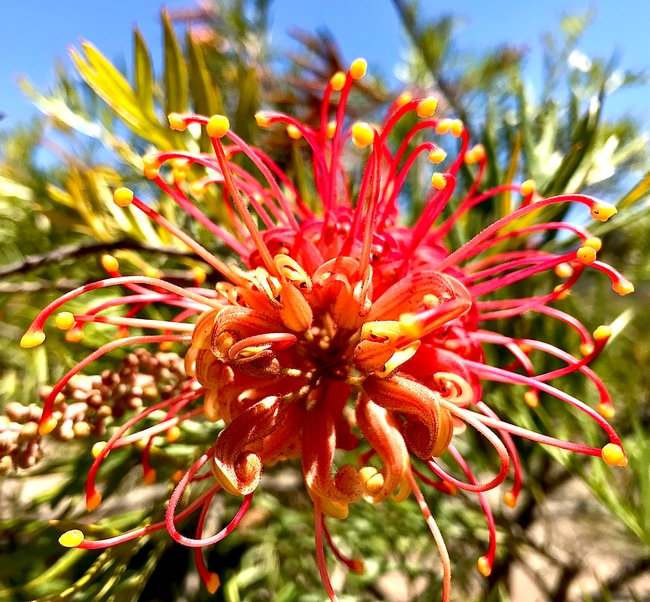- Author: Polly Nelson
- Editor: Noni Todd
Capturing Rainwater
By Polly Nelson UCCE Master Gardener
When the rains came earlier this year, did you watch water run off your landscaping to the street (aka urban drool), or did it soak into your soil? What changes did you think about making during that time? What changes make sense now, in hopeful anticipation of rain later this year?
Rain barrel acquisition, creating bioswales and rain gardens, and transitioning hardscape to more porous surfaces in your landscaping are options to consider.
Most everyone has heard about purchasing rain barrels. I have five 50-gallon rain barrels placed around the four corners of my house. Hooked up to downspouts, they fill with the first inch of rain that falls each year. After that, the rain bypasses the barrel to flow out into the landscaping. Bigger barrels would store more water, but space and expense negate that option for me, and 250 gallons of water meet my needs into summer. If you decide to purchase rain barrels, make sure it has a removable lid so it can be cleaned. A faucet and a hose attachment port at the bottom make content removal easier.
My roof provides more rain than the barrels accommodate, so I have sought additional solutions. Directing downspouts to planted areas points the water to a useful destination once the rain barrels are full. Creating a bioswale channel with curves and mounds to form a dry riverbed with stones and vegetation is visually pleasing during the year, and functional in the rainy season to slow, spread, and sink water into the soil as it journeys across the landscape. Succulents fare well in my bioswale, pictured above, along with Dymondia (Dymondia margaretae) as a ground cover.
A bioswale is a conduit for water, while a rain garden is a bowl-shaped destination to capture and allow water infiltration into the soil, away from buildings. Plants that do well in rain gardens include Pacific Coast Iris (Iris douglasiana); Western Sword Fern (Polystichum munitum); Yarrow (Achillea); California Fuchsia (Epilobium canum); California Buckwheat (Eriogonium fasciculatum); Gooseberry (Ribes); and California Poppy (Eschscholzia californica).
Consider transitioning away from concrete, asphalt, and non-porous surfaces in your landscape and replace them with porous, permeable pavers and bricks. Install gravel pathways where possible to allow water to soak into the surface, capturing rainwater runoff instead of sending it to storm drains. These landscape alternatives will help us reduce the dreaded urban drool.
- Author: Beth Wray
- Author: Tami Reece
- Author: Sophia Stevens
- Editor: Jennifer Hopkins
UC Master Gardeners, whose mission is to extend research-based knowledge and information on home horticulture, pest management, and sustainable landscape practices to the residents of San Luis Obispo County, is now officially in Paso Robles, welcoming residents to visit their new demonstration garden at the Centennial Park. On Saturday, Aug. 12, the UC Master Gardeners of San Luis Obispo County will host an Open House from 8 to 11 a.m. at 600 Nickerson Drive in Paso Robles.
The garden project has been two years in the making, beginning in August 2020 when the initial conversations started with the City of Paso Robles and the University of California Regents for the UC Master Gardener Program of San Luis Obispo County to take responsibility for the 3,500-square-foot garden space at the city's Centennial Park.
“The City of Paso Robles is thrilled to partner with the Master Gardeners of SLO County to present a beautifully renewed Centennial Park Demonstration Garden for the benefit, enjoyment and education of our community,” said Community Services Director Angelica Fortin. “As we continue to develop this 3,500-square-foot garden space together, we will focus on demonstrating water conservation, providing food to the hungry and inviting community interaction. We believe the garden will become a special place for community members to learn and grow together toward these common goals.”
UC Master Gardener volunteers will be stationed in the garden to discuss the eight different garden plots, which reflect the joint goals of the two organizations for this garden space: developing community green spaces, demonstrating water-wise gardening practices, donating food to local food banks, and providing opportunities for community education.
Soon, workshops will be scheduled at the garden, with topics such as home landscape design, pest identification, and management, pruning, what plants do and don't grow well locally, as well as other topics, keeping in mind the special climate requirements of North County. Workshop topics at the new garden will also be selected based on survey results collected at the upcoming Open House in August. Input from the community on preferred format and scheduling is encouraged and appreciated.
Future plans for the garden will include monthly open garden days, where UC Master Gardeners will be in the Centennial Park Demonstration Garden to answer questions.
“We're so thrilled to engage with the North County and help support their gardening success,” said Maria Murrietta, program coordinator for the UC Master Gardener Program of SLO County. “While we've had a strong presence in San Luis Obispo at the Garden of the Seven Sisters Demonstration Garden, this new garden offers a second beautiful place to host UC Master Gardener Program events and engage with home gardeners who have questions or want to learn more about gardening.”
For more information about the UC Master Gardeners of San Luis Obispo County, call (805) 781-5939 or visit ucanr.edu/sites/mgslo/.
- Author: Deborah Light-Pacheco
- Editor: Noni Todd
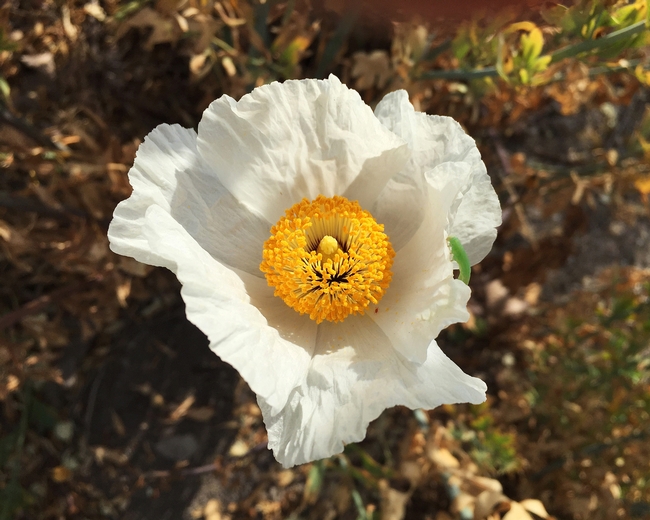
Matilija Poppy
By Deborah Light-Pacheco UCCE Master Gardener
Common name of plant: Matilija poppy
Scientific name: Romneya coulteri
Planting area: Sunset zones, 4-12, 14-24: H1
Size: 6-8 feet tall, spreading
Bloom Season: late spring into summer and fall with irrigation
Exposure: full sun
Pruning needs: cut to nearly the ground in late fall
Water needs: little or no water to moderate water
Snapshot: This shrubby perennial is a beautiful native of California and Baja California. The Matilija poppy, also known as tree poppy, can spread indefinitely by rhizomes. It has thick stems with grayish-green foliage. This plant produces enormous, 4”- 8” scented blossoms, with 5-6 white crepe paper-like petals. The stamen is bright yellow making the flower look like a fried egg. The flowers may be cut and used in a vase or as part of an arrangement. However, they should be cut in the bud stage as the flowers are short lived.
Planted on a hillside, they work as a soil binder preventing erosion and if used on a roadside, they can fill out a marginal area or provide a privacy screen. Their spreading habit can be considered invasive so use caution in your placement within a yard. The Matilija poppy is tolerant of a variety of soils and once established, they can grow freely and may need to be kept in check!
In the fall, cut nearly to the ground and new shoots will sprout after winter's first rains. Matilija is deer resistant and drought tolerant.
Though this plant is prolific once established, it is a challenge to propagate. If attempting to create more plants, try digging up rooted suckers or taking cuttings from the thickest part of the stem. Seeds are tricky to germinate.
Fun facts: this flower was once a contender for being named the California state flower. The name Matilija comes from Chief Matilija, a Chumash leader. To read a short story on the Chumash connection, see “Stories Behind a Few Favorite Flower Names” by Sarah Angelo https://ucanr.edu/blogs/blogcore/postdetail.cfm?postnum=46449
- Author: Jutta Thoerner
- Editor: Noni Todd
California buckeye
By Jutta Thoerner UCCE Master Gardener
Aesculus californica
Tree size: up to 30 feet tall
Bloom description and season: spring flowers are white to pale pink, 6-8 inches long and 2-3 inches wide
Pruning needs: prune during dormant season
Exposure: sun to partial shade
Water needs: regular watering during the first growing season.
The buckeye tree is a fascinating specimen. It can grow in a wide range of conditions from moist, partially shaded canyons to dry south facing slopes or hilltops. It can be found as a single tree in dry grasslands or mixed with evergreens or oaks in forest environments. Seeds can be planted at a depth of twice its diameter in well-worked, loosened soil. In 2- 3 years the plants will produce their first bloom.
For home gardeners, it is planted as an ornamental tree because of the beautiful lime colored foliage, unusual leaf buds, and fantastic white and very fragrant spring flowers. The leaves turn red-brown foliage in late summer, often completely defoliating in summer leaving large pear-shaped fruits hanging on bare branches. This tree changes its look again when showing off graceful silver branches through the winter.
The buckeye tree, with all its beauty and stately presence, comes with a long list of cautions. Its bark, leaves and fruit contain the neurotoxic glycoside aesculin, which causes hemolysis of red blood cells. The nectar and pollen of the flowers is toxic to honeybees. However, the flowers produce ample nectar and many species of butterflies consume the nectar without problems.
The buckeye fruit gives rise to seeds that are smooth, mahogany brown with a large gray spot which resembles the eye of a deer. These are a favorite snack of chipmunks and squirrels but should not be eaten by livestock. Many Native American tribes made use of the seeds by going through a complex soaking and leaching process to remove the toxins and tannins making the nut safe to eat.
If you want a tree in your landscape that will be around for up to 300 years, the California buckeye will be up for the job.
- Author: Megan Edwards
- Editor: Noni Todd
Grevillea
By Megan Edwards UCCE Master Gardener
‘Grevillea ‘Superb'
Proteaceae (Proteas)
Planting areas: Sunset Zones 16-24
Size: 5' wide to 6' tall
Bloom season: late winter to late autumn.
Exposure: full sun to partial shade
Pruning needs: not regularly required; can handle modest to heavy pruning when needed.
Water needs: low
“A Superb Ornamental Shrub”
Do you have your eyes on the Grevillea family of evergreen shrubs? The handsome Grevillea ‘Superb' is an excellent choice. This hybrid is an upright, airy ornamental shrub and is well-adapted to our Mediterranean climate and landscaping aesthetic. Let's explore the valuable attributes Grevillea ‘Superb' has to offer in three main areas: ornamental, landscaping and, environmental.
Ornamental features dominate in this Australian native, with mesmerizing clusters of coral-pink and yellow flowers that bloom nearly year-round. Its delicate fern-like foliage lends itself well to propagation cuttings and floral arrangements alike.
The landscaping attributes include the overall low-maintenance needs and versatility. The delicate and open composition make for an eye-catching, stand-alone accent with a compact appearance. Grevillea ‘Superb' should be planted four to six feet apart to allow for its six-foot canopy and sufficient root space. With this in-mind, Grevillea ‘Superb' is a good choice for courtyards, xeriscapes, cottage and Mediterranean-themed gardens; and excellent as hedges, screens, boarders and windbreaks. A word of caution: some people experience skin irritation when in contact with the Grevillea foliage. Proceed carefully when exploring this ornamental plant.
Grevillea ‘Superb' requires little water once established and will tolerate high heat and poor soil, making it a natural choice for water-wise gardening goals. Its abundance of nectar is a veritable buffet for butterflies, bees, and hummingbirds. As an added bonus, it is deer resistant! Grevillea typically has few insect pest issues, but should be monitored for scale and mealybugs regularly. Monitor the plant's overall health for early detection of issues related to soil nutrients and water management.
The low-maintenance needs and aesthetic values make this Grevillea truly superb!


